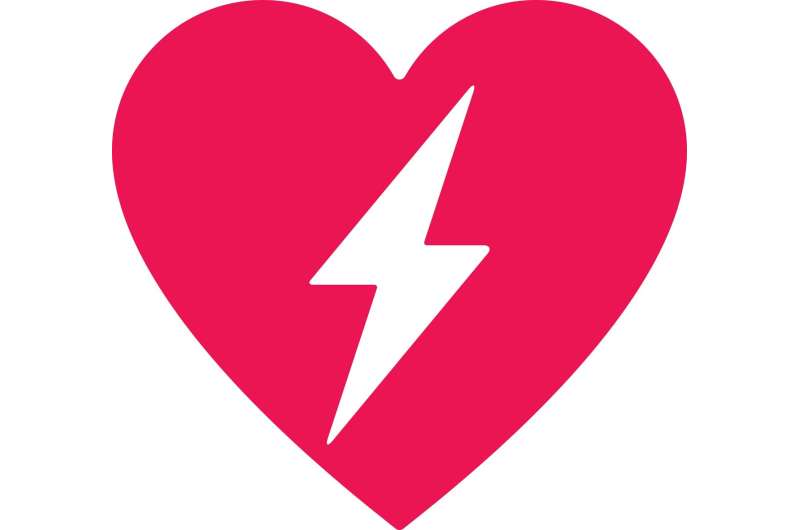This article has been reviewed according to Science X's editorial process and policies. Editors have highlighted the following attributes while ensuring the content's credibility:
fact-checked
trusted source
proofread
First-in-human study demonstrates reduction of hard-to-reach ventricular tachycardias

A new technology using ultralow temperature cryoablation (ULTC) has eliminated clinical ventricular tachycardia (VT) in 94% of patients. The late-breaking science is presented at EHRA 2024, a scientific congress of the European Society of Cardiology (ESC).
VT is a leading cause of sudden death in patients with heart failure and a reduced ejection fraction. Approximately 30% of patients with ischemic and non-ischemic cardiomyopathies develop ventricular arrhythmias including VT. Typical therapies to prevent VT include antiarrhythmic medication, such as amiodarone, and an implantable cardioverter-defibrillator (ICD).
Principal investigator Dr. Atul Verma of McGill University Health Centre, Montreal, Canada said, "Amiodarone suppresses VT but cannot eliminate it. In addition, the drug is associated with multiple serious side effects, which can lead to discontinuation in approximately 30-40% of patients.
"ICDs can successfully terminate VT with pacing or shocks, but the shocks are painful and are associated with increased mortality in the long-term. Ablation is an important option to eliminate VT but there have been no significant advancements in this therapy since the development of radiofrequency 15 to 20 years ago."
Cryocure-VT was a first-in-human clinical trial evaluating the safety and efficacy of ULTC for the treatment of recurrent monomorphic VTs in patients with ischemic and non-ischemic cardiomyopathies. ULTC is a new energy source which produces very deep lesions in ventricular tissue and penetrates scar—essential qualities for successful VT ablation. Current technologies, like radiofrequency, achieve limited tissue depth and cannot penetrate scar tissue.
"The novelty of this trial is the design of the catheter, which can deliver ULTC (down to -180 C) and produce lesions of different tissue depths depending on the duration of the freeze," said Dr. Verma.
"By estimating tissue depth, either from preprocedural or intraprocedural imaging, the operator can choose which depth is required to treat the VT and deliver the required duration of ULTC. This was the first study to investigate whether the technology could work in patients."
Cryocure-VT was a single arm study conducted at nine centers in Belgium, Canada, Czechia, France, Germany, and the Netherlands. The study included 64 patients with a history of VT, an indication for ablation, a history of ischemic or non-ischemic cardiomyopathy, and an ICD already implanted or planned for implantation immediately after ablation. The mean age of participants was 67 years and three (4.7%) were women. All patients underwent the ablation procedure using the ULTC catheter and the operator's choice of electroanatomical mapping system.
The primary endpoints were acute non-inducibility of clinical VTs at the end of the procedure, freedom from major adverse events at 30 days, freedom from any sustained VT (>30 seconds) at six months, and freedom from ICD intervention at six months.
The primary acute effectiveness endpoint of non-inducibility of clinical VTs post-procedure occurred in 94% (n=51/54) of patients in whom post-ablation induction was attempted. All VTs were eliminated in 85% (n=46/54) of patients. There were no protocol-defined major adverse events at 30 days.
There were four serious adverse events (6%), including one asymptomatic ventricular pseudoaneurysm, one small pericardial effusion which resolved without intervention, one small pericardial effusion which was drained, and one case of haemodynamic instability requiring extracorporeal membrane oxygenation (ECMO) support. One patient died of heart failure 26 weeks after the procedure.
At six months, 38 patients (60%; n=38/63) remained free of any sustained VT, and 51 patients (81%; n=51/63) remained free of ICD shocks. There were no significant differences between ischemic and non-ischemic cardiomyopathy patients.
Dr. Verma said, "ULTC ablation of monomorphic VT was effective and relatively safe in patients with ischemic and non-ischemic cardiomyopathies. The success rates for this novel procedure were at least as good, if not better, than prior VT radiofrequency ablation trials.
The complication rates were consistent with other VT ablation trials. This technology is promising and may be an important advance for VT ablation by allowing the targeting of deeper mid-myocardial, and even epicardial, substrates. More studies, including randomised trials using this device in patients with monomorphic VT, are needed."
More information: www.escardio.org/Congresses-&-Events/EHRA-Congress




















